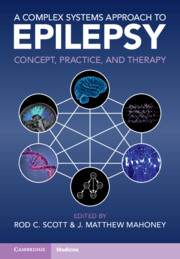Book contents
- A Complex Systems Approach to Epilepsy
- A Complex Systems Approach to Epilepsy
- Copyright page
- Contents
- Contributors
- Chapter 1 Introduction
- Chapter 2 Systems Biology Approaches to the Genetic Complexity of Epilepsy
- Chapter 3 Transcriptomic and Epigenomic Approaches for Epilepsy
- Chapter 4 Phenomenological Mesoscopic Models for Seizure Activity
- Chapter 5 Personalized Network Modeling in Epilepsy
- Chapter 6 The Baseline and Epileptiform EEG
- Chapter 7 Neuronal Approaches to Epilepsy
- Chapter 8 Mapping Epileptic Networks with Scalp and Invasive EEG
- Chapter 9 A Neuroimaging Network-Level Approach to Drug-Resistant Epilepsy
- Chapter 10 Epilepsy as a Complex Network Disorder
- Index
- References
Chapter 2 - Systems Biology Approaches to the Genetic Complexity of Epilepsy
Published online by Cambridge University Press: 06 January 2023
- A Complex Systems Approach to Epilepsy
- A Complex Systems Approach to Epilepsy
- Copyright page
- Contents
- Contributors
- Chapter 1 Introduction
- Chapter 2 Systems Biology Approaches to the Genetic Complexity of Epilepsy
- Chapter 3 Transcriptomic and Epigenomic Approaches for Epilepsy
- Chapter 4 Phenomenological Mesoscopic Models for Seizure Activity
- Chapter 5 Personalized Network Modeling in Epilepsy
- Chapter 6 The Baseline and Epileptiform EEG
- Chapter 7 Neuronal Approaches to Epilepsy
- Chapter 8 Mapping Epileptic Networks with Scalp and Invasive EEG
- Chapter 9 A Neuroimaging Network-Level Approach to Drug-Resistant Epilepsy
- Chapter 10 Epilepsy as a Complex Network Disorder
- Index
- References
Summary
The genetic underpinnings of epilepsy have come into much clearer focus over the past two decades. Advances in high-throughput molecular techniques have markedly improved our ability to identify potential therapeutic targets in epilepsy. Many of the monogenic effects identified through these methods have resulted in effective therapeutic targets for seizure amelioration [1,2,3]. Currently, around 200 definitively annotated epilepsy genes causing a range of seizure disorders and phenotypes have been identified [4]. Many more genes with putative associations with epilepsy pathways require further study [5]. The expansion of known genetic mechanisms and risk factors presents us with several benefits, including an increased pool of possible drug targets [6], genetic subtyping of seizure disorders [7], and the possibility for integrative analysis across different disorders [8,9]. However, the increasingly rich collection of genetic associations has also revealed the complexity of seizure disorders. Many mutations in different genes can converge on a similar clinical presentation [10], while different mutations in the same gene can have radically divergent outcomes [11,12]. Moreover, while robust data from twin and family studies demonstrate that common epilepsies are highly heritable [13,14], association studies have only detected risk factors that account for a small fraction of risk [15]. Thus, the data on epilepsy suggests a dichotomy. On one side, genetics is critical for describing etiology [16]. On the other side, using this information for prognosis or therapeutic development is limited by our current understanding of the complex genetic underpinnings of the disease and our analytic tools [10,17]. As a response to this complexity, researchers have started to shift toward complex systems approaches to genetics, which changes the focus from individual mutations to interactions among many mutations. The purpose of this chapter is to elaborate this ethos and present examples of this approach.
- Type
- Chapter
- Information
- A Complex Systems Approach to EpilepsyConcept, Practice, and Therapy, pp. 5 - 18Publisher: Cambridge University PressPrint publication year: 2023



